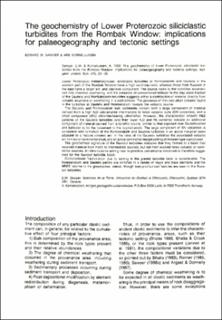| dc.contributor.author | Sawyer, Edward W. | |
| dc.contributor.author | Korneliussen, Are | |
| dc.coverage.spatial | 13311 Skjomen | |
| dc.coverage.spatial | 14314 Narvik | |
| dc.coverage.spatial | 14313 Skjomdalen | |
| dc.coverage.spatial | NARVIK | |
| dc.coverage.spatial | 14311 Bjørnfjell | |
| dc.coverage.spatial | EVENES | |
| dc.coverage.spatial | HAMARØY | |
| dc.coverage.spatial | 14312 Cunojavri | |
| dc.coverage.spatial | 13312 Frostisen | |
| dc.date.accessioned | 2020-08-26T09:00:42Z | |
| dc.date.available | 2020-08-26T09:00:42Z | |
| dc.date.issued | 1989 | |
| dc.identifier.uri | https://hdl.handle.net/11250/2674075 | |
| dc.description.abstract | Lower Proterozoic metamorphosed, siliciclastic turbidites at Rombaksbotn and Gautelis in the western part of the Rombak Window have high sand\/clay ratio, whereas those from Ruvssot in the east have a larger silt- and clay-size component. The source rocks to the turbidites experienced little chemical weathering, and the presence of unweathered feldspar in the clay-sized fraction of the Gautelis and Rombaksbotn turbidites suggests either a contribution of material directly from volcanic eruptions or weathering in a cold climate. The presence of thin calc-alkali volcanic layers in the turbidites at Gautelis and Rombaksbotn favours the volcanic source. The Gautelis and Rombaksbotn bulk sediments contain both a large component of material derived from a high K2O calc-aline intermediate to felsic volcanic suite (SN volcanites), and a small component (<5%) chromite-bearing ultramafics. However, the characteristic smooth REE patterns of the Gautelis turbidites (and their lower K2O and Rb contents) indicate and additional component of material derived from a tonalitic source, similar to that exposed near Gautelisvatnet and belived to be the basement to the supracrustals. The large component of Sn volcanites is consistent with formation of the Rombaksbotn and Gautelis turbidites in an active marginal basin adjacent to a mature volcanic arc. In the case of the Gautelis turbidites the associated volcanic arc formed on continental crust, and an active continental margin setting of Andean-type is proposed. The geochemical signature of the Ruvssot turbidities indicates that they formed in a basin that received material from mafic to intermediate sources, but not from evolved felsic volcanic or continental sources. An intra-oceanic setting near to primitive calc-aline volcanism is therefore suggested for the Ruvssot turbidite basin. Compositional fractionation due to sorting th | |
| dc.language.iso | eng | |
| dc.relation.ispartofseries | NGU Bulletin (415) | |
| dc.rights | Navngivelse 4.0 Internasjonal | |
| dc.rights.uri | http://creativecommons.org/licenses/by/4.0/deed.no | |
| dc.title | The geochemistry of Lower Proterozoic siliciclastic turbidities from the Rombak Window, implications for palaeogeography and tectonic settings. | |
| dc.type | Journal article | |
| dc.description.localcode | 36224 | |
| dc.source.pagenumber | 23-38 | |

